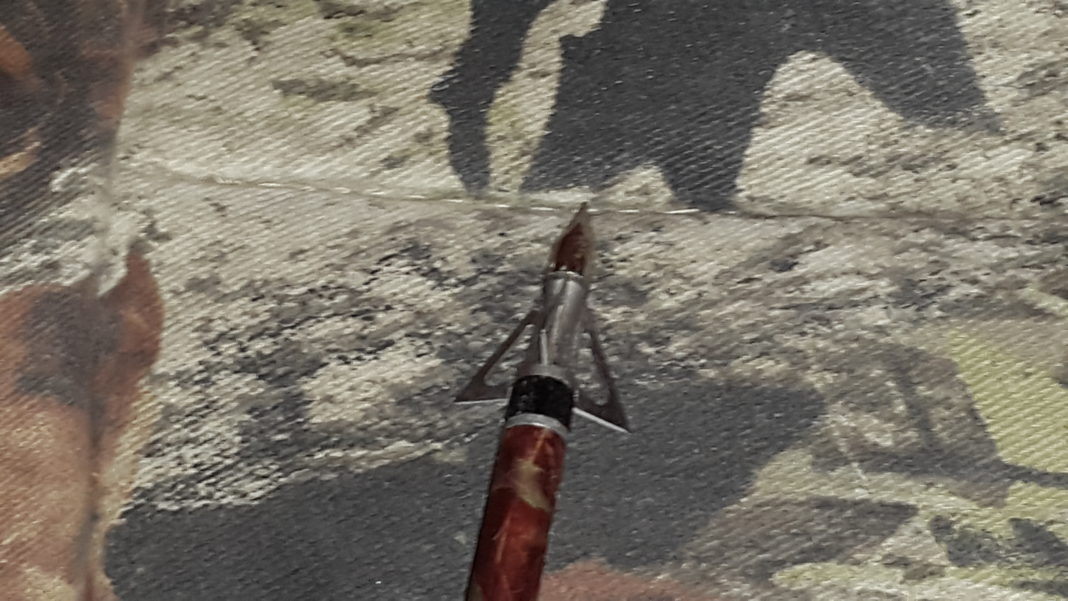Over the last several years I have shared many campfires with big-game hunters all across the country. One thing I continuously see is the high numbers of hunters that have dull broadheads in their quiver.
Get in a conversation with a bowhunter and the talk will normally revolve around the types of bows, quivers, arrows, sights, and rests that are being used. There will be some chatter on broadheads, mainly mechanical vs. fixed blade, but never on sharpness. Why?
It’s not surprising for me to talk with hunters who’ve had the same broadheads on their arrows for several hunting seasons, with no maintenance being done to them. After all the talk on the importance of sharp broadheads, I can’t understand why hunters still choose not to give more thought to the deadliest part of their entire setup.
Broadheads kill in one of two ways. One way is by causing blood loss in extreme amounts. The second way is by stopping heart, liver, lung, or kidney function. A broadhead that is as sharp as it should be slices through the animal and does not destroy very many blood cells, which keep the blood from clotting. Therefore, it does not take long for an animal to bleed out. When a hunter uses a dull broadhead, instead of slicing cleanly through the animal, it tears through the animal. A rough wound like this will damage a lot of blood cells. This allows the wound to quickly clot, preventing the much-needed blood loss that results in a quick death.
A surprising number of bowhunters either do not know the importance of sharp broadheads, or if they do, they simply choose to ignore it. I wish every hunter could understand the importance of a clean cut that is provided by a razor-sharp broadhead, as compared to a dull broadhead, and how a dull broadhead does not even cut as it passes through the tissue. Instead, it tears or even stretches the tissue, which does not result in an ethical kill.
Once an animal has been shot with a broadhead, do not hunt with it again until the blades are once again razor sharp. This also goes for broadheads you have used during target practice, or one that has been shot in the dirt one too many times after you shot over the back of your intended target.
Mechanical broadheads or replaceable-blade broadheads have a quick fix to dullness. Simply buy a cheap pack of replaceable blades and put them on the broadhead. The more traditional one-piece broadhead, like the Bear Razorhead I shoot with my recurve, requires the blades to be sharpened again by hand. A couple of good models are on the market that quickly put a razor-sharp edge on the broadhead. I use a sharpener manufactured by G5.
If for some reason you have to try to sharpen a broadhead with blades, go ahead and do it, but quickly replace the blades as soon as you can. Blades that have been sharpened are better than dull blades, but they present a problem. The blade will be weakened and instead of a razor-sharp edge, it will be more of a jagged edge that easily breaks. If you’re not careful, your broadhead will once again be dull, and you’ll be left with what you started with. Why don’t you carry a small package of replaceable blades with you and skip the worries of having to try and sharpen your blades?
Don’t be fooled into believing a broadhead straight out of the package is sharp enough to take hunting. Check the blade to make sure it’s sharp. If it’s not, switch brands and/or notify the manufacturer of the problem you encountered.
Broadhead manufacturers strive to offer their customers the very best in broadheads, including a broadhead that is as sharp as possible. They use microscopes comparable to what you see on CSI. When the broadhead is placed under magnification, they are able to notice even the smallest defect in blade sharpness. Another method that they use is a sharpness tester that measures the blade sharpness. Both techniques are not something a hunter can do at home, so we as hunters have to rely on old-fashioned tests to make sure the blade passes the sharpness test.
The same way I witnessed my grandpa test his knives is how I check my broadheads. If they will shave the hair off of my arm, there is no doubt in my mind that they will cut through an artery.
It is our duty as ethical hunters to make clean, one-shot kills on the animals we hunt. This is done by taking shots at game only when they’re in a good position, staying within an effective range, and by using the very best equipment we can. This includes razor-sharp broadheads.
The whole point of this article can easily be summed up. Never stick an arrow in your quiver unless the business end of that arrow is sharp enough to shave with. We owe it to the animal we’re hunting and we certainly owe it to the good name of ethical hunters everywhere.
Tell us what you think in the comments section below.



















![The Best Deer Camp Chili [VIDEO] Deer Chili Ingredients, Tomatoes, Chili Spices](/wp-content/uploads/2015/10/Deer-Chili-Deer-Camp-Recipe-218x150.jpg)
![How to Call Elk Early in the Season [VIDEO]](/wp-content/uploads/2016/08/byers003-218x150.jpg)




![Idiots Disturb Hunter: How Would You Have Handled It? [VIDEO]](/wp-content/uploads/2015/10/DSC00110-e1474487693878-100x70.jpg)
![Albino Buck Shocked to Shed His Antlers [VIDEO]](/wp-content/uploads/2015/10/AlbinoDeer-100x70.jpg)